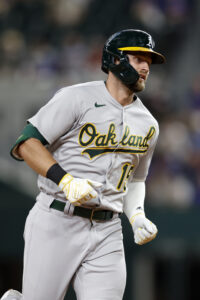The A’s are firmly amidst a rebuild. They stripped the roster almost to its studs over the 2021-22 offseason, dismantling what had been a borderline playoff team to cut spending. Matt Chapman, Matt Olson, Sean Manaea and Chris Bassitt all departed last winter; Frankie Montas followed at the deadline, and Sean Murphy was the last big piece to move a few weeks ago.
With all their star players out the door, Oakland has mostly completed its sell-off. They’re now integrating a number of younger, pre-arbitration players onto a roster that again figures to be one of the worst in the American League in 2023. The A’s are looking a few years down the road, and it stands to reason they’d therefore be open to moving virtually any player on the roster with an established major league track record.
Ramón Laureano may be their highest-upside trade candidate, but he’s coming off a rough season that’s a year removed from a performance-enhancing drug suspension. It’s probably best to let him try to rebuild his stock with an eye towards a deadline deal. There’s another outfielder whom general manager David Forst could consider more of a sell-high possibility: Seth Brown.
A former 19th-round pick, Brown was never regarded as an especially notable prospect. He didn’t reach the majors until after his 27th birthday late in the 2019 season. Brown barely played at the MLB level his first couple years, not topping 26 MLB games in a season until 2021. He picked up 307 plate appearances that year, connecting on 20 home runs but only reaching base at a .274 clip.
Last season, the Lewis-Clark State College product got his first real run as an everyday player. He suited up 150 times and tallied 555 trips to the plate. Brown hit .230/.305/.444 with 25 homers. His on-base percentage, while a bit below the .312 league mark, wasn’t at the untenable clip of the previous season. He cut his strikeout rate from 29% to a more manageable 26.3% while boosting his walk percentage to a solid 9.2% clip. Brown still doesn’t have a great plate discipline profile, but those numbers are sufficient for a player with his power. His slugging mark was nearly .050 points above the league average despite playing half his games at Oakland’s spacious ballpark.
Virtually all of those gains came as part of a torrid second half. Brown carried a .216/.269/.396 line into the All-Star Break. After the Midsummer Classic, he posted a .249/.348/.507 showing over 250 plate appearances. He more than doubled his walk rate from 6.2% to 12.8% and collected 15 longballs in the second half. He finished tied for 11th in the majors in homers after the Break, while his 147 wRC+ during that time (indicating overall offensive production 47 percentage points above the league average) checked in 27th among those with at least 150 plate appearances.
As with any relatively small-sample performance of that nature, it’s probably fair to assume Brown won’t maintain that pace. He doesn’t need to be a top 30 hitter in the league to be valuable, though, and it’s clear he has legitimate power upside. He’s now picked up 45 homers in a bit less than 900 plate appearances over the past two seasons. In both years, he’s put up a hard contact rate north of 40% — around five points higher than the league mark.
Even with some likely regression from his late-season tear, Brown at least profiles as a quality power bat for the strong side of a platoon. For his career, the left-handed hitter owns a .239/.309/.482 line against right-handed pitching. He’s managed only a .172/.230/.297 mark against southpaws and would probably be shielded from looks against tough lefty arms if he were to land with a contender.
A decent runner, Brown also stole 11 bases in 13 attempts last season. The A’s even gave him some late-season work in center field, though he struggled significantly there. Public metrics suggest he’s a more viable defender in the corner outfield and at first base. The bat will have to carry the profile, but Brown has enough athleticism he could factor in at a few of the lower-value positions on the defensive spectrum.
There haven’t been any indications Brown’s name has come up in trade talks between Oakland and other clubs thus far. Unlike most of the players the A’s have shipped off in recent seasons, they have no payroll motivation to deal Brown. He’ll play this season for little more than the league minimum salary and is eligible for arbitration three more times after that. Trading him wouldn’t be about saving money but the opportunity to potentially recoup a mid-level prospect or two for a player whose trade value may be at its peak. While he’s controllable for the foreseeable future, Brown is already 30 and presumably not seen as a core long-term organizational piece for a rebuilding club.
A productive lefty platoon bat to rotate through the corner outfield and first base should have more appeal to an immediate contender, particularly since Brown’s affordability means he’d fit on the books anywhere. Teams like the Rays, Yankees, Rangers, Braves, Brewers and Dodgers all have some amount of uncertainty at either first base or in the outfield. Tampa Bay and New York stand out as particularly strong speculative fits considering their lineups tend to skew right-handed. Brown wouldn’t be a franchise-altering addition, but he should be of interest to a number of teams as they build out their roster depth with free agency mostly finished.
Image courtesy of USA Today Sports.

